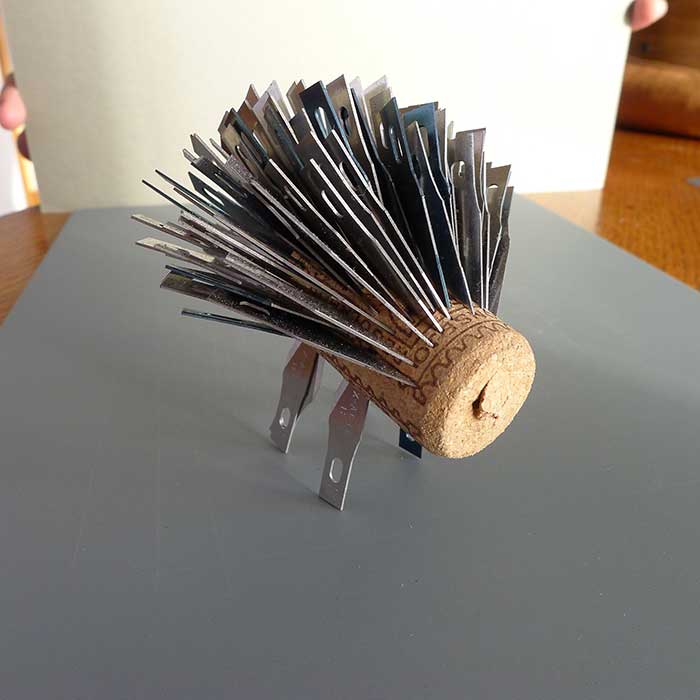How to Construct an Ullagami Model
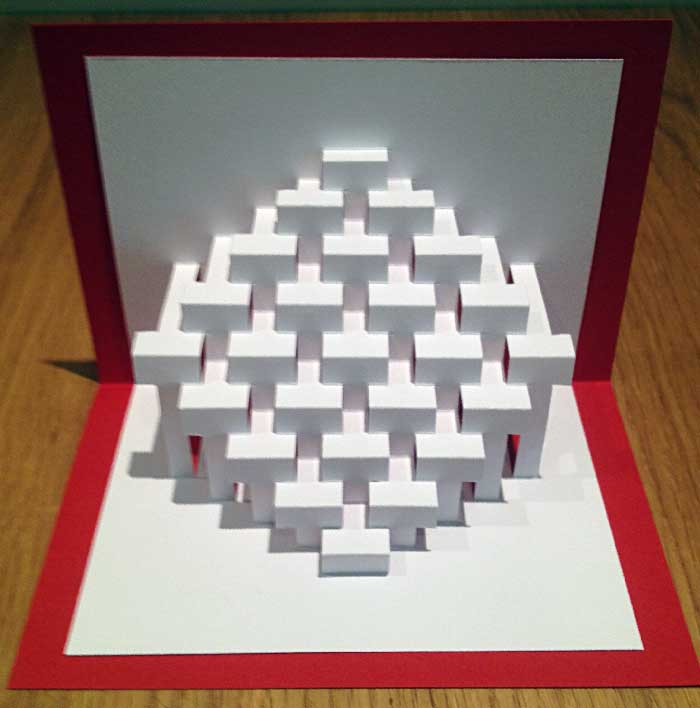
If you’ve already had some experience with kirigami and origamic architecture, then the basic instructions I typically supply to people who want to try my designs read as follows:
1. Print the template onto regular paper. 2. Tape or very lightly glue-stick one edge of the template to the card. 3. Through the paper into the card, score all the fold lines with an embossing point. 4. Cut all the cut lines with a scalpel or xacto. 5. Inspect the back to make sure it all looks right. 6. Remove the template from the card. 7. Using your fingers, reinforce all the scored creases in their proper directions. 8. Gently massage the piece into its final form. The whole thing folds flat when it’s finished. Good luck!
That’s really all there is to it. Sounds simple, right? And if you’re comfortable with that, you need read no further. However, having watched many people learn to cut my designs, with all different levels of experience and skill, I have seen many of the mistakes, pitfalls and missed intuitions that can naturally occur. One way to counter that is with a youtube video...
...but if you still want the most detailed, most complete description of (what I consider to be) the best methods and practices for constructing these designs, then please, dear reader, read on.
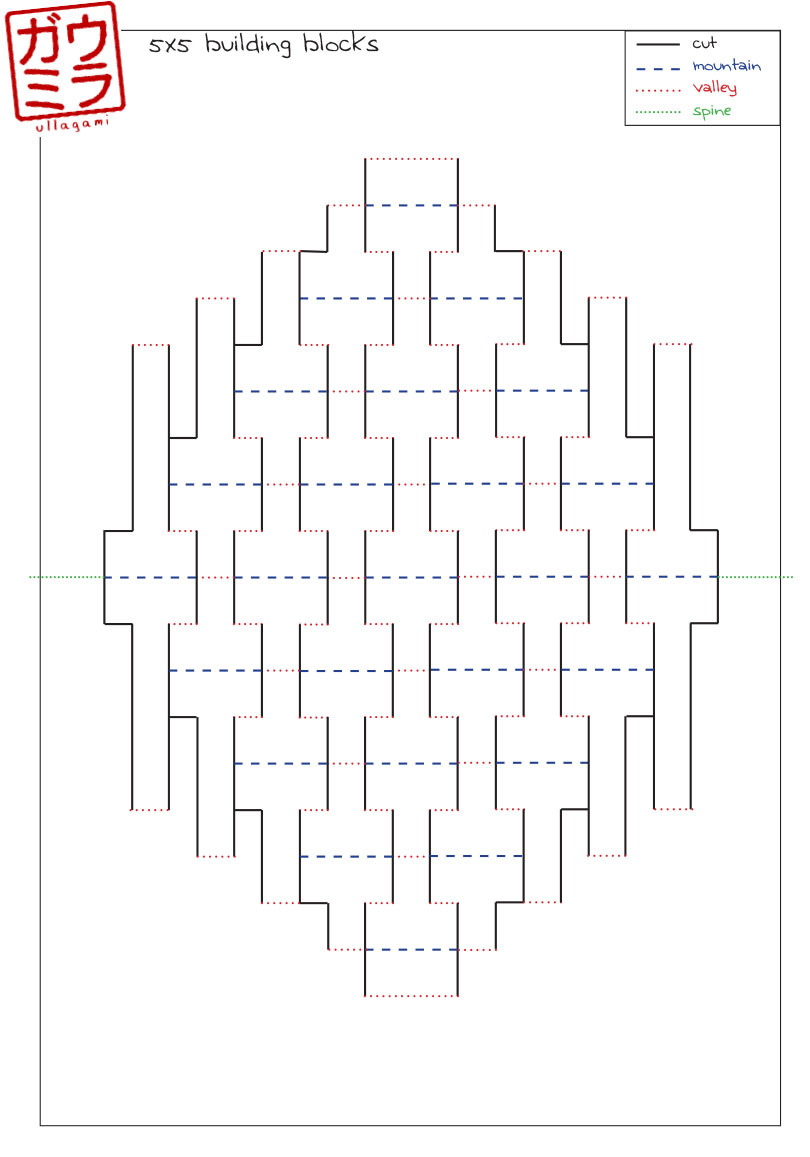
For teaching and diagrammatic purposes, We will use the “5x5 building blocks” model. You can download the template here. It’s simple enough to learn on, while just complex enough to reveal the techniques required by some of the more advanced designs. Once you get the hang of it, the basic method for all the pieces I design, regardless of difficulty level, is fundamentally the same.
Also it’s worth noting that the instructions that follow are not set in stone. Everyone has their own intuitions and preferences; here we’ll merely discuss certain tried-and-true methods that always work reliably.
Step 1: Preparation
Before you do anything else, make sure you have everything you need. These constructions require a little bit of focus and concentration, and having all your tools and materials assembled from the start is a good idea. Put a fresh blade in your scalpel. Wipe down your cutting mat. In fact (and here’s a really good trick), close your eyes and lightly feel the entire surface of your cutting mat with your fingertips. This is more important than it sounds: when tips break off of scalpel blades, they often lie in ambush, embedded in the surface of the mat, waiting for another scalpel blade to come along and break too. Feeling the mat with eyes closed helps you find any of these little land mines before they can get in the way of your construction.
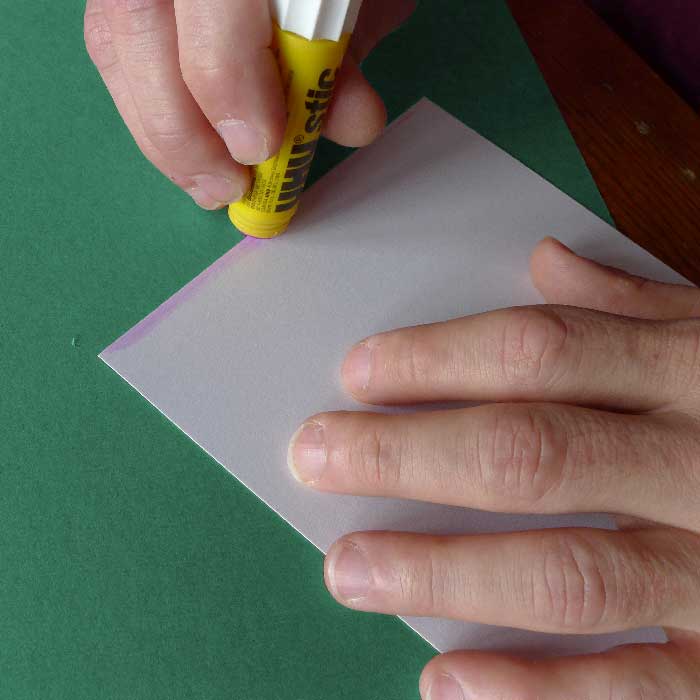
With all the materiel ready to go, the next step is to photocopy or print the template onto a sheet of normal white copy paper the same size as the card you want to use for your model. My books are coil-bound for easy copying, and many of my models completely scalable, either vertically, horizontally, or entirely. The templates are in color, but photocopying is fine: they work equally well in black and white.
Then attach the template to the card, using whatever adhesive you prefer. A glue stick is the quickest, easiest method. It’s surprising how little glue you need: just the barest edge, a millimeter or two at most, across the top of the card will hold the template in place quite nicely. Some glue sticks even come in colors which dry clear, so you can see exactly how much you apply. You want to use enough glue to ensure that the template doesn’t slip, but minimal enough to allow the two sheets to easily separate later on. A single glue stick can last more than a year, even if you do this a lot.
Quick tip: never use your cutting mat as a gluing surface. A piece of scrap paper (or your most recently cut template) will protect your cutting mat from getting sticky.
Once the template is attached to the card, place it on your mat, and you’re ready to start.
Step 2: Scoring.
It’s worth mentioning at the start that the term “score” can actually have two meanings in this context. Scoring can mean “cutting lightly through the topmost layer of the paper’s surface” (some people even use the back of a scalpel blade, rather than an embossing pont, for this purpose); or it can alternatively mean “compressing the paper in a sharp line without breaking the surface of the paper at all.” This book uses the term in that second sense: it’s better to compress the paper than to lightly cut it, so it doesn’t split along the folds. And now we return to or originally scheduled program:
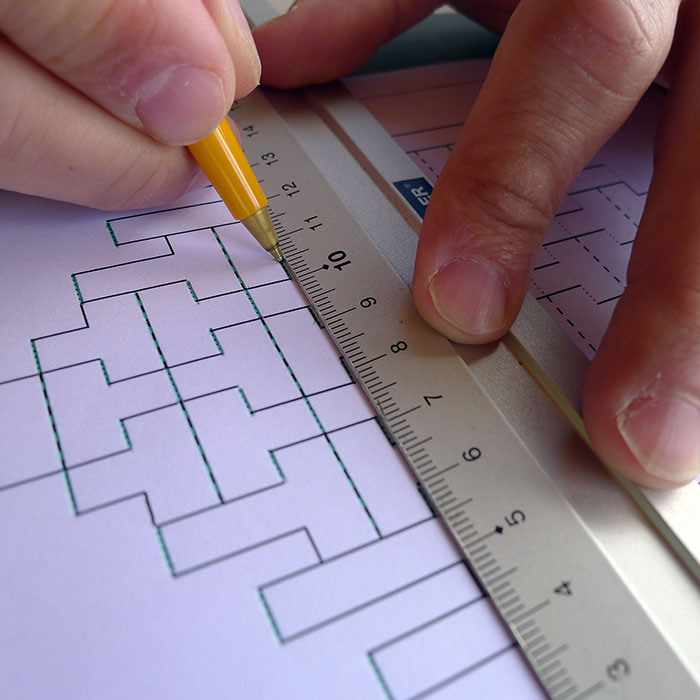
When you bend or stress a piece of card enough to fold it, it looks for a natural place to “break.” Depending upon the thickness and fiber of the card, these natural break-points can be unpredictable and untidy, as the card seeks to crease along the path of least resistance. It is therefore necessary to pre-score the card using an embossing point, laying out the fault-lines, so that later when it’s time to fold the model into its final shape, all the folds break precisely and neatly where you need them to be. This process of pre-scoring a card gives it a map of lines along which to naturally fold by itself, a path of least resistance which you control and provide, making the folding process much easier.
Curved folds don't collapse flat, so the scores in Ullagami templates are all straight lines. This makes this part of the construction relatively simple: using your ruler, line up the template lines (which are always dotted lines) you want to score and, one at a time, drag your embossing point precisely along each, pushing hard enough to make a clear and sharp indentation in the card, but not so hard that you cut through the template with your point. Then reposition your ruler on the next line to score and do it again, until all the dotted lines have been scored.
The embossing point is the traditional tool for this job. But in this context, I find that a ball-point pen works even better. The tip rolls, rather than drags, across the surface of the paper, and even leaves a nice inky indicator of which lines you have already done. Look for a fine-tip pen, and one with relatively dry ink, to prevent it soaking through the paper.
click here to see a few tips for scoring
- If it’s any kind of dotted line on the template, score it. at this stage, mountain- and valley-folds are treated identically. They all score exactly the same.
- Rely on your ruler. pressed firmly down onto the template, let the ruler guide your embossing point along the page. It’s the surest way to make the straightest, cleanest lines.
- Work in the right direction, and only in one direction. On models where the score lines lie parallel to the glued edge, always start at the glued side of the template and move away from the attached edge. If you begin at a free (unattached) edge and work toward the attachment, the template can tend to ripple and bunch up atop the card, which doesn’t help the accuracy of your work. By progressing always away from the glued edge, the ruler will smooth out the template as you go.
- Work systematically. You don’t want to miss out any of the score lines, only to discover too late that there are missing scores. The best way to avoid this is to move the ruler from one side of the page to the other, catching every score line it passes.
- When possible, line up the score lines together. In many of the models in this book, the score lines fall in collinear groups. You can line up your ruler across several at a time, which also helps ensure that it is at precisely the right angle when scoring.
- Use constant speed and pressure. The smoother and less “lumpy” your score lines are, the neater the folds they create will ultimately be.
- Don’t overthink. All the thought process for the design of the models in this book is already in the template when you begin construction. You don’t need to question the placement of the lines on the page, or worry about how they work together. Your mind is free of such details, allowing you to focus on the meditative side of things, feeling the work as you proceed and being methodical and steady in your work.
- Don’t move the card on the mat, just move the whole mat. The more you shift the template and card around relative to the mat, the more chance there is that they might wrinkle or buckle, or (gasp!) detach. If you need to adjust the positioning of the template relative to your hands or tools, it’s better to move the whole cutting mat, keeping the card in its fixed position on top.
After all the dotted- and dashed lines have been scored, you can see from the underside of the card a neat pattern of ridges where the embossing point has passed. All the fold lines are ready for the folding stage later on. But first we have some cutting to do...
Step 3: Cutting
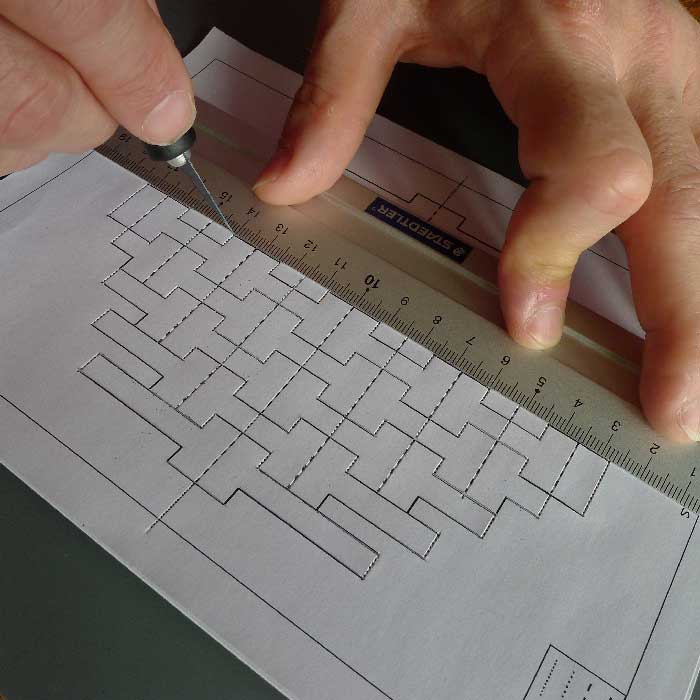
In many ways, this step is both parallel and perpendicular to the scoring process. Again using your ruler, progress systematically across the page from one edge to the other, cutting through all the solid lines with the point of your scalpel. The general method for this is point, sink, drag, lift. Position the point of the blade on the starting end of the cut you want to make, and plunge it gently but firmly downward, through the template and card, and into the mat. You can feel a small tactile thud as it pierces through. Then as smoothly as possible drag the blade along the cut-line, to the end, and finally lift the scalpel out, straight up. Many of the techniques from the scoring stage also apply here: work away from the attached edge, work systematically from one side to the other, line up collinear cuts with your ruler, and use steady speed and pressure when moving the blade through the card.
click here to see a few tips for cutting
- Cut all the vertical lines first, and then all the others. This is a general rule, and in some specific cases there may be exceptions, but for the sake of methodicalness and in the interest of not missing out any cuts (and also of avoiding cutting the same lines twice) it’s usually best to be very systematic.
- Use enough pressure, but not too much. Firm hand, light touch. The pressure should be enough to cut cleanly through the template and the card, without going overboard: the deeper the blade sinks into the mat, the less accurate your cuts will be, as the width of the scalpel increases away from its tip. Cut through the template and the card, but try not to scar the mat. If you find you have a habit of pressing too hard, it might help to print your templates on slightly thicker paper.
- Keep the blade as vertical as possible. In the interest of precision and control, the more upright you keep the blade when it penetrates the paper, the less metal will actually enter the surface of the paper and card, resulting in sharper, more accurate cuts. It’s also easier to see what you’re doing when the blade is out of your way. Only the tip, and never the long edge, of the scalpel, should ever come into contact with the paper.
- Always recap the blade when it’s not in your hand. Simple, stupid advice, but sometimes it’s quite convenient to just set the blade down without re-capping it. Those things are sharp, you know. Make capping the blade second nature when you put it down, it’s a safe habit to have. And these models look better without blood on them.
- When two cuts intersect but don’t cross, start at their intersection and work away from the juncture. This is a subtle suggestion, but if you drag the blade toward an existing cut in the paper, the cutting resistance will suddenly diminish when it reaches the pre-existing slit in the card. In this case it’s very easy to slightly lose control of the scalpel, and overcut by a very small amount. Conversely, if you’re expecting to feel the pre-existing cut as you reach it, the tendency is to cut too lightly as you approach it, which should also be avoided. Given the option, cut always away from a cut, not towards it.
- Keep your blade sharp, and replace it at the slightest snap. Frequently it is only the very extreme tip of the point of the scalpel – less than a millimeter – which will eventually snap off, leaving the rest of the blade still looking almost new. It may be tempting to continue cutting, but since the sharp tip of the blade does most of our heavy lifting, for best results you should swap in a new blade whenever there’s any damage to the tip at all.
Step 4: Inspect, Disconnect, Inspect Again
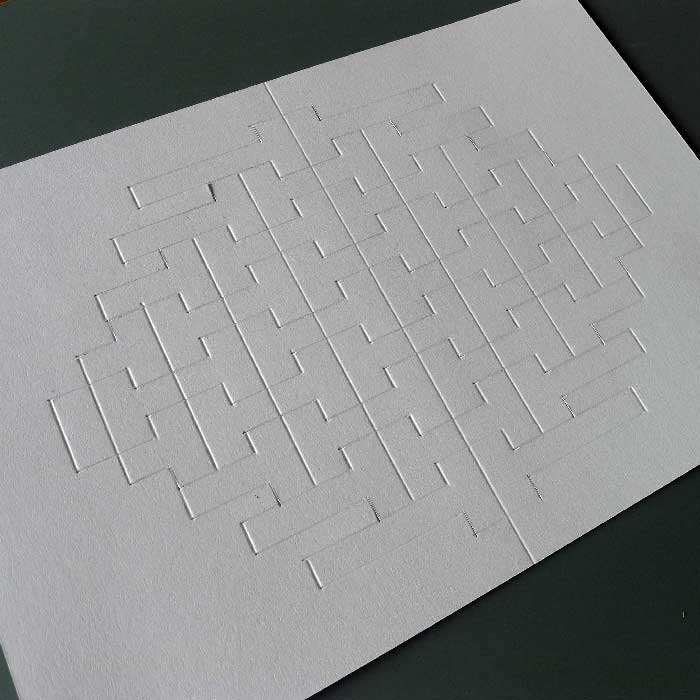
After you have finished scoring and cutting all the lines in the pattern, turn the template and card over, and lay them, still connected, on the cutting mat. This is your chance to inspect your work before detaching the template from the card. Once the template is detached, it’s nigh impossible to get it realigned properly with the card. Have a close look at the template in good light. Make sure all the cuts went through properly. Make sure that there are no scores or cuts which are missing from the pattern. After you’ve had a little experience and practice, you should be able to spot missing elements quite easily, but as a general rule, no cut or score should ever end without another cut or score connecting to and continuing it. If you see a cut or score line that just ends by itself, it’s a good indicator that there’s something missing.
Once you’re sure that all the scores and cuts are in place, you can disconnect the template from the card. There are two ways to do this. Most directly, you can simply peel the template away from the card, carefully so that there’s no ripping or rippling (this is why you should use as little glue as possible). Alternatively, you can cut out along the frame lines which border the page. Every template in this book has frame lines set about a centimeter in from the edges of the page, and by cutting these lines, you also cut away the glued edge, freeing the card underneath. Make sure that you cut the frame line closest to the glued edge last, as it’s holding the template in place for the other three cuts. Keep the template on hand for the next step, and throw away the rectangular frame of paper.
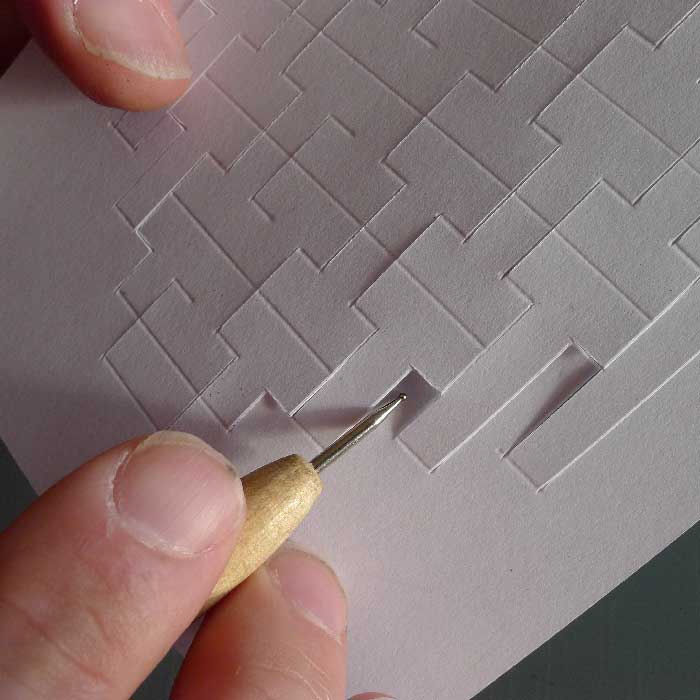
Now you have a pristine card, with the template etched into it. Time for one last inspection before folding. Very often, there are tiny ‘tags’ of paper connecting the places where two cuts intersect, and we need to resolve this before we can fold the model. So with your embossing point, work around the edges of the model, tapping on the intersections, making sure the cuts connect, and that the central design is completely free of the background card. It’s much easier to do this verification step now, while your card is still completely flat. When you’re assured that all the adjoining cuts solidly connect, it’s time to start the most satisfying part: folding your model.
Step 5: Folding
Here’s where we turn a flat sheet of card into a 3D model. The first thing to know about this phase is that it’s a gradual process. Since all the folds are interdependent, it’s not possible to make them 90° one at a time, without stressing the paper. If we could fold them all simultaneously, then we could just collapse the whole thing at once, but in the real word the trick is to systematically and repeatedly increase all their angles, bit by bit, until the each of the folds reaches its final position.
A quick note about the different types of fold-lines in these templates: There are three kids of fold-lines marked. A “mountain” fold (dashed lines, in blue) angles away from the paper and toward you, like a mountain. A “valley” fold (small dotted lines, in red) points the opposite way, away from the viewer and toward the background page. The “spine” folds (dotted lines, green)are really just valley folds, but the spine is the central fold of the whole model, separating the wall from the floor, so it is marked slightly differently.
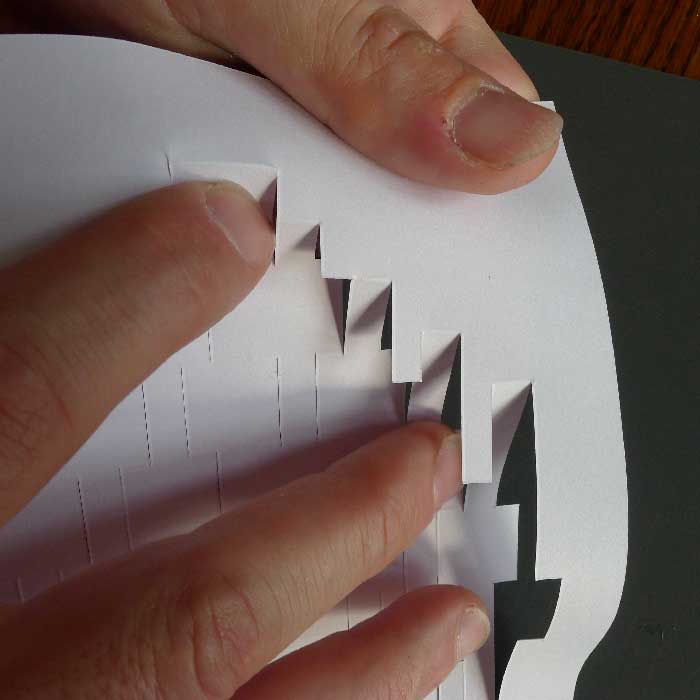
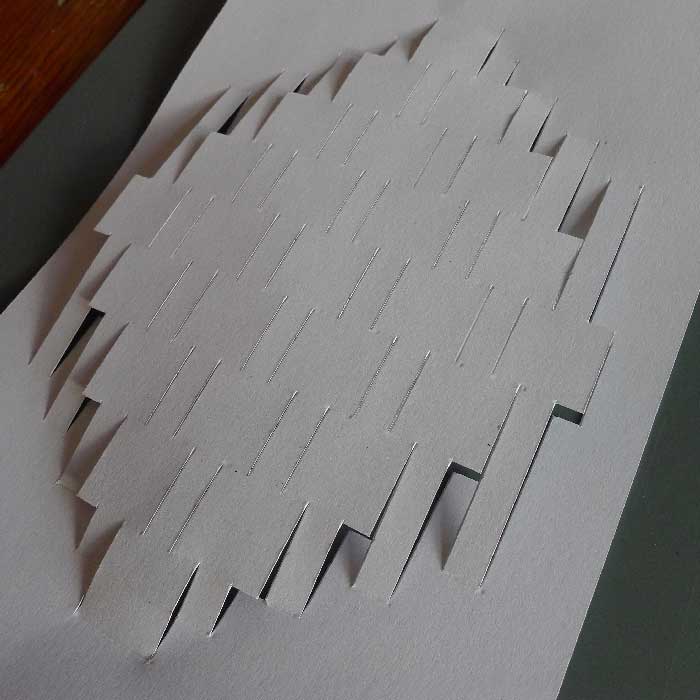
To start, begin by “puffing out” the central design from the surrounding paper, lifting the model away from its background, as follows: first, fold the spine lines. There are usually only ever two of these lines, which extend from the edges of the central design to the edges of the card. This spine is actually the primary fold for the whole model: it is what separates the floor from the wall, so to speak. Using your fingers, pinch-crease these two lines so that they fold to a 90° angle.
Next, work your way around the borders of the design with your fingers, gently popping the whole central section away from the surrounding card. The cuts should lift away cleanly, and where there are scores around the edges of the model, delicately start to fold them. Don’t worry about making them sharp 90° angles yet — they won’t hold that angle until the other folds are done too — but by gently guiding the card to fold along these score lines, you begin the process, and you can see the model start to lift away from its background. Go all the way around, until you have a sort of “pillow” of card raised away from the surrounding surface.
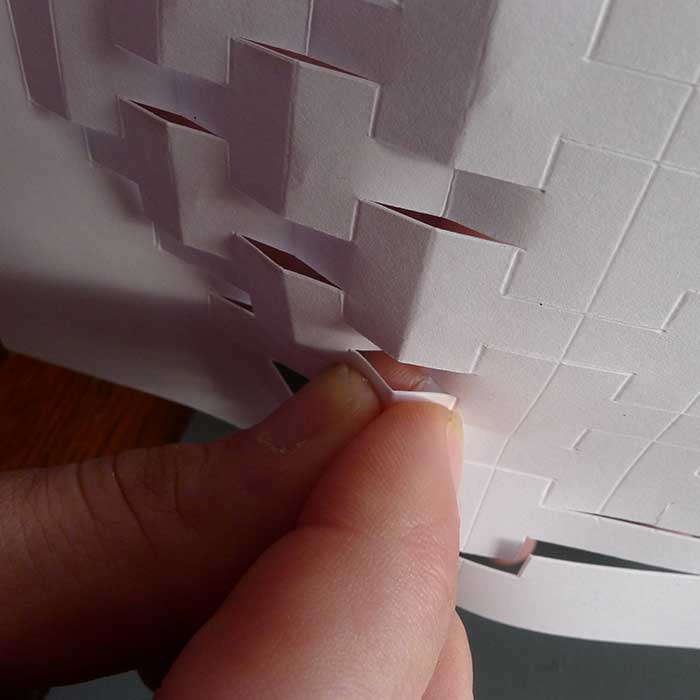
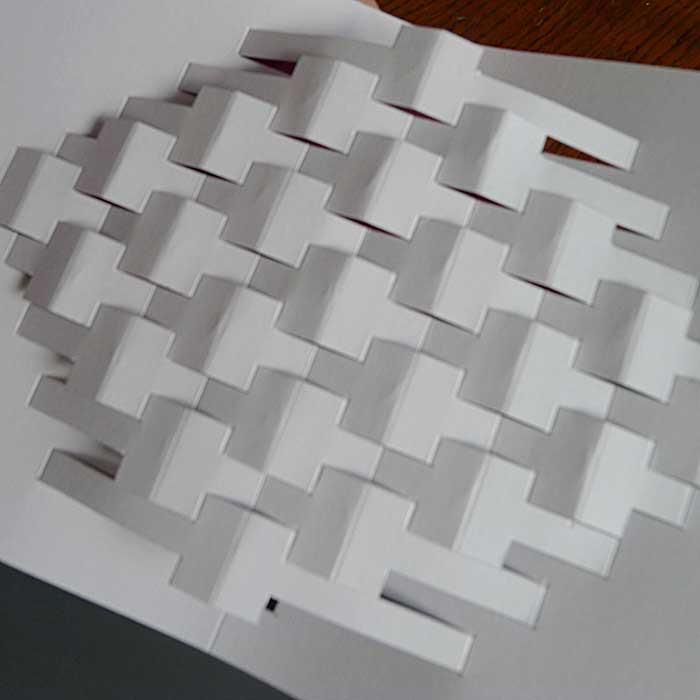
Now comes the nitty-gritty part: working systematically through the model, nudge each score line into a fold in its appropriate direction, either mountain or valley. After a bit of experience it will become clear which lines will ultimately become mountain folds and which valleys, but you can always use the template you started with as a guide. It’s generally easiest to begin with the biggest folds on the page, which are usually mountain folds. Working from both the front and back of the card, push out from behind these mountain folds with a fingertip, while gingerly pinching the line into a crease on the front side of the card with your other hand. Remember, the reason we scored the fold lines in the first place was to give the card a natural place to crease when flexed; this is where we do that flexing and creasing. They don’t have to be 90° angles yet, we just need to show the card, one score line at a time, which way it should fold when the real crunch comes later on. One at a time, reinforce every crease on the page. As you go, the general form of the final model should start to emerge. It’s tricky and time-consuming, but this step is important: if all the folds are given a proper start, there will be no ambiguity when the final folding happens, and as a result, there will be no warping or ripples in the final model. Be methodical and consistent. For most models, it’s best to work from the edges in toward the center, but ultimately the order in which you approach the folds is less important than making sure you get them all. For creases that are too small for your fingertips, you can always use a tool to help you, and also remember you can work on both sides of the card, pinching the mountains from the front, and the valleys from behind.
After all the folds have been initially guided, each in its proper direction, go back and work through them all again, increasing their sharpness. Depending upon the model, this might take a few passes, incrementally nudging all the folds toward their proper conclusions. But once you’re satisfied that they all know where to go, then it’s time for the final crunch.
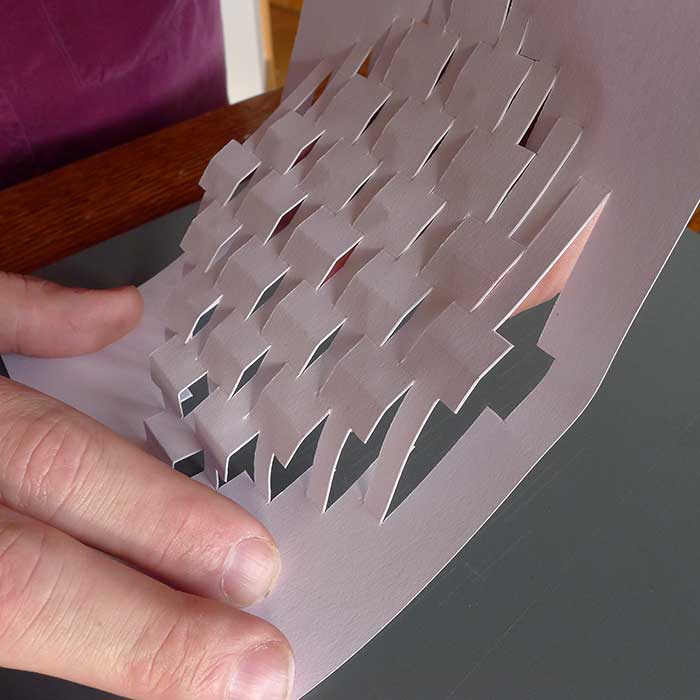
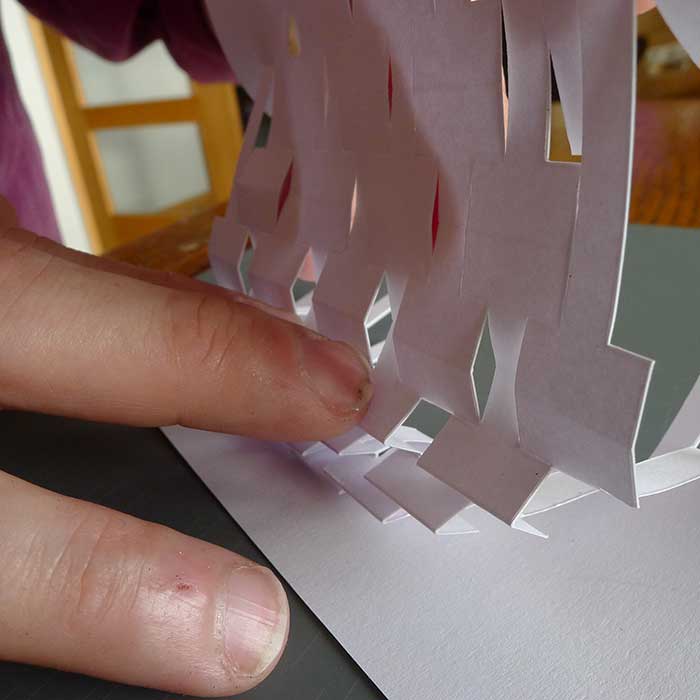
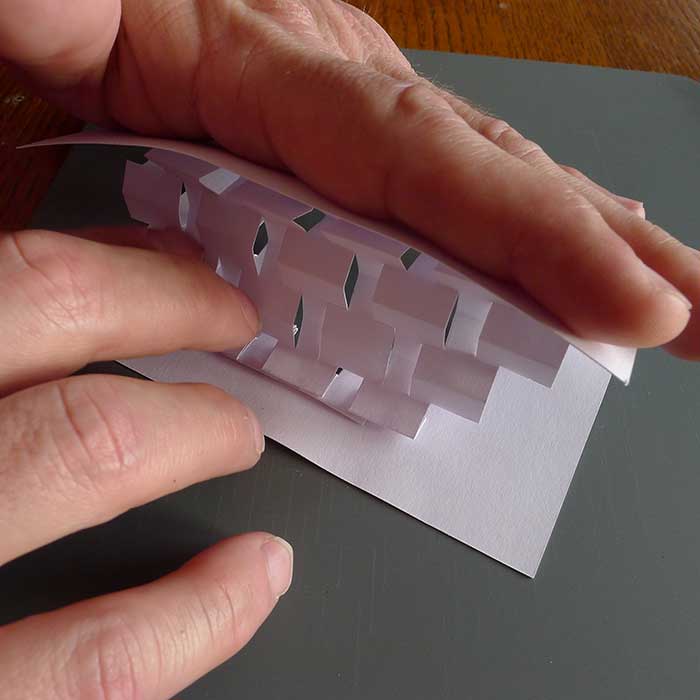
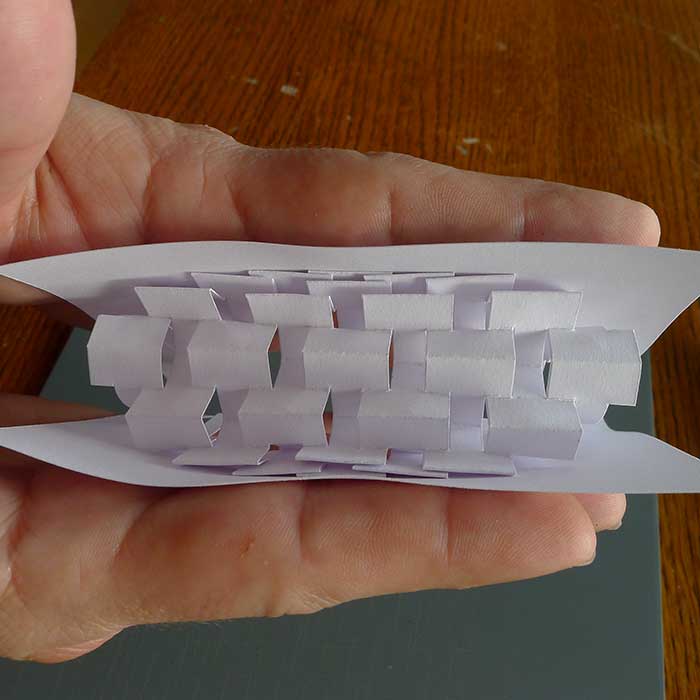
The goal now is to get the entire model to fold along the spine, and collapse flat on its face. Hold the card’s bottom edge flat upon the table and gently angle the spine toward 90°. This will put some pressure on all the lines we scored and folded. Keeping that pressure steady, start with the bottom-most block, and collapse it forward until its face folds flat onto the background, and the top folds flat onto the face. Then do the same with the next row of blocks. And again. As you progress farther away from the bottom row this will become more difficult; sometimes it’s tricky to get a physical grip upon the surfaces you want to work on, but be patient and, row by row, they should fold flat. If you notice any of the scored folds resisting collapse, you might need to occasionally pause and revisit some of the individual folds and once again nudge them in their proper directions as you go. When it gets frustrating, or when you get near the center of the model, turn the whole thing around, and start from the top down using the same techniques. Eventually, the centermost rows of the model will be the only ones left un-collapsed. At this final stage, if they don’t seem like they’ll easily fall into place by themselves (which does happen occasionally), it can sometimes be effective to grip the whole card almost like a sandwich, applying pressure from both the top and bottom, and gently squeeze until the whole card folds flat.
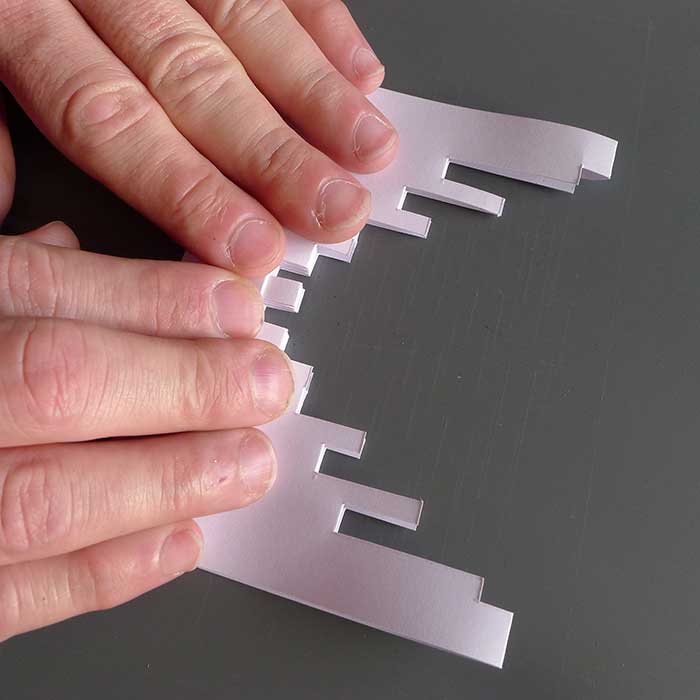
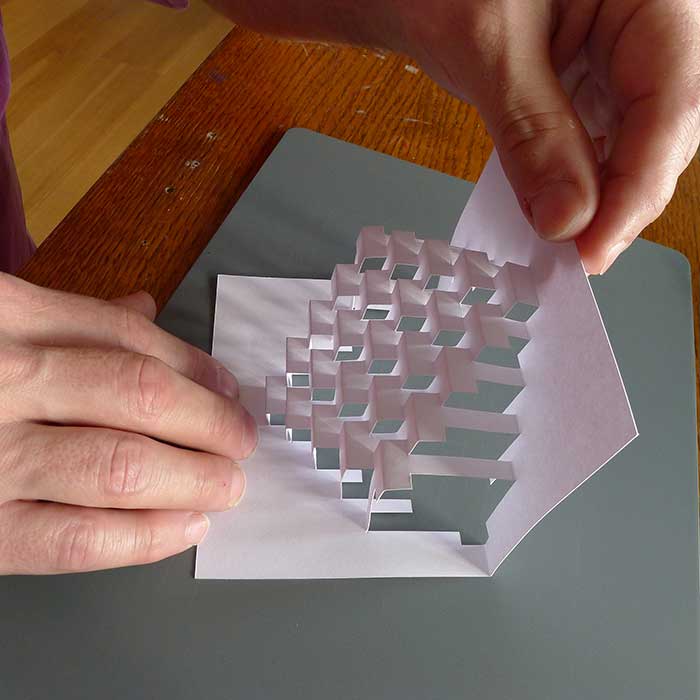
And finally, the best part: from its completely collapsed state, peel the card open like a book, until the spine is once more at a 90° angle. And there’s your model! The only thing left now is to look it over and re-crease any folds that don’t seem sharp enough, making sure that every fold is at last a right angle. Then turn it over, and do the same with the valley folds from the back. And voila! Your model is complete!
(Step 6: Do it again)
If your final model has extra creases and wrinkles, ripples or small tears, don’t be discouraged. Even with loads of practice, it’s rare to make a model perfectly the first time. So think of the first try as a familiarization process, learning which bits are trickiest and where you could be more careful. Certainly with some of my more complex designs, it has taken several (indeed many) attempts before achieving a perfect result. But perfection is possible, with just a little more practice.
click here to see some final leftover tips and shortcuts
- Surrender yourself to a certain amount of imprecision. This is supposed to be relaxing, not stressful. Keep the inaccuracies and imperfections to a minimum, of course, but don’t get flustered if something goes wrong. It’s only paper.
- Feel the paper as you go. Not to get all Obi-Wan on you, but feeeeeeeel. With enough experience you should be able to feel the texture and the fiber of both the template and the card beneath, through the point, as it drags along the template. With this sensitivity, you will learn to score and cut neat, even lines that start and end precisely. And not to get all Yoda on you, but eventually you will be able to feel the differences between different cards, different types of cutting mats, and even different table surfaces, all through the embossing point and the scalpel. Even the sounds different papers make when you work with them will help you understand the textures and fibres you’re working with.
- Use the right size ruler for the job. Cutting and scoring across the width of an A4 card, use a 20cm ruler, and then switch to the 30cm to work vertically on the same sheet. The reason for this is two-fold: you want a tool that is long enough for the purpose without being so long that it gets in your way; and also if the ruler more or less fits the whole length or width of the page, it does a better job of gripping without warping the surface, which in turn helps to keep the template and the card together and where you want them to be.
- Don’t work at the big shared table at the coffeehouse. It shakes when people use it.
- Have a safe system for your discarded blades. The old blades can pile up quickly, and they’re still razor sharp. This makes them difficult to just throw into the bin, as they easily slice through any trash bag. By keeping a small, solid container on hand, like an old Tic-Tac box, for example, you can safely collect them for later disposal when the box gets full. Or, alternatively, consider using a wine cork: with enough blades, you can make a very handsome hedge-hog!

